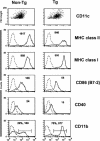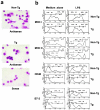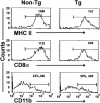The AIDS-like disease of CD4C/human immunodeficiency virus transgenic mice is associated with accumulation of immature CD11bHi dendritic cells
- PMID: 14557658
- PMCID: PMC229375
- DOI: 10.1128/jvi.77.21.11733-11744.2003
The AIDS-like disease of CD4C/human immunodeficiency virus transgenic mice is associated with accumulation of immature CD11bHi dendritic cells
Abstract
CD4C/human immunodeficiency virus (HIV) transgenic mice develop an AIDS-like disease. We used this model to study the effects of HIV-1 on dendritic cells (DC). We found a progressive decrease in total DC numbers in the lymph nodes, with a significant accumulation of CD11b(Hi) DC. In the thymus, the recovery of transgenic CD8alpha(+) DC had a tendency to be lower. Spleen DC were augmented in the marginal zone. Transgenic DC showed a decreased capacity to present antigen in vitro, consistent with their reduced major histocompatibility complex class II expression and impaired maturation profile. The accumulation of immature DC may contribute to disease and may reflect an adaptive advantage for the virus by favoring its replication and preventing the generation of fully functional antiviral responses.
Figures






Similar articles
-
Anatomic location defines antigen presentation by dendritic cells to T cells in response to intravenous soluble antigens.Eur J Immunol. 2007 Jun;37(6):1453-62. doi: 10.1002/eji.200636544. Eur J Immunol. 2007. PMID: 17474148
-
The Nef-mediated AIDS-like disease of CD4C/human immunodeficiency virus transgenic mice is associated with increased Fas/FasL expression on T cells and T-cell death but is not prevented in Fas-, FasL-, tumor necrosis factor receptor 1-, or interleukin-1beta-converting enzyme-deficient or Bcl2-expressing transgenic mice.J Virol. 2005 May;79(10):6377-91. doi: 10.1128/JVI.79.10.6377-6391.2005. J Virol. 2005. PMID: 15858021 Free PMC article.
-
Bone marrow-derived dendritic cells, infection with human immunodeficiency virus, and immunopathology.Annu Rev Immunol. 1997;15:593-615. doi: 10.1146/annurev.immunol.15.1.593. Annu Rev Immunol. 1997. PMID: 9143701 Review.
-
Dendritic cell subtypes in mouse lymphoid organs: cross-correlation of surface markers, changes with incubation, and differences among thymus, spleen, and lymph nodes.J Immunol. 1997 Jul 15;159(2):565-73. J Immunol. 1997. PMID: 9218570
-
Follicular dendritic cells and infection by human immunodeficiency virus type 1--a crucial target cell and virus reservoir.Curr Top Microbiol Immunol. 1995;201:161-88. doi: 10.1007/978-3-642-79603-6_10. Curr Top Microbiol Immunol. 1995. PMID: 7587350 Review. No abstract available.
Cited by
-
Altered immune response differentially enhances susceptibility to Cryptococcus neoformans and Cryptococcus gattii infection in mice expressing the HIV-1 transgene.Infect Immun. 2013 Apr;81(4):1100-13. doi: 10.1128/IAI.01339-12. Epub 2013 Jan 22. Infect Immun. 2013. PMID: 23340313 Free PMC article.
-
Blood B Lymphocyte Stimulator (BLyS)/BAFF levels may reflect natural immunity to HIV in highly exposed uninfected Beninese Commercial Sex Workers.Sci Rep. 2016 Aug 26;6:32318. doi: 10.1038/srep32318. Sci Rep. 2016. PMID: 27561453 Free PMC article.
-
Influence of dendritic cells on B-cell responses during HIV infection.Clin Dev Immunol. 2012;2012:592187. doi: 10.1155/2012/592187. Epub 2012 Feb 22. Clin Dev Immunol. 2012. PMID: 22461837 Free PMC article. Review.
-
Overexpression of activated murine Notch1 and Notch3 in transgenic mice blocks mammary gland development and induces mammary tumors.Am J Pathol. 2006 Mar;168(3):973-90. doi: 10.2353/ajpath.2006.050416. Am J Pathol. 2006. PMID: 16507912 Free PMC article.
-
High expression levels of BLyS/BAFF by blood dendritic cells and granulocytes are associated with B-cell dysregulation in SIV-infected rhesus macaques.PLoS One. 2015 Jun 24;10(6):e0131513. doi: 10.1371/journal.pone.0131513. eCollection 2015. PLoS One. 2015. PMID: 26107380 Free PMC article.
References
-
- Andrieu, M., D. Chassin, J. F. Desoutter, I. Bouchaert, M. Baillet, D. Hanau, J. G. Guillet, and A. Hosmalin. 2001. Downregulation of major histocompatibility class I on human dendritic cells by HIV Nef impairs antigen presentation to HIV-specific CD8+ T lymphocytes. AIDS Res. Hum. Retrovir. 17:1365-1370. - PubMed
-
- Bakri, Y., C. Schiffer, V. Zennou, P. Charneau, E. Kahn, A. Benjouad, J. C. Gluckman, and B. Canque. 2001. The maturation of dendritic cells results in postintegration inhibition of HIV-1 replication. J. Immunol. 166:3780-3788. - PubMed
-
- Banchereau, J., and R. M. Steinman. 1998. Dendritic cells and the control of immunity. Nature 392:245-252. - PubMed
-
- Bjorck, P., L. Flores-Romo, and Y. J. Liu. 1997. Human interdigitating dendritic cells directly stimulate CD40-activated naive B cells. Eur. J. Immunol. 27:1266-1274. - PubMed
Publication types
MeSH terms
Substances
Grants and funding
LinkOut - more resources
Full Text Sources
Medical
Molecular Biology Databases
Research Materials

